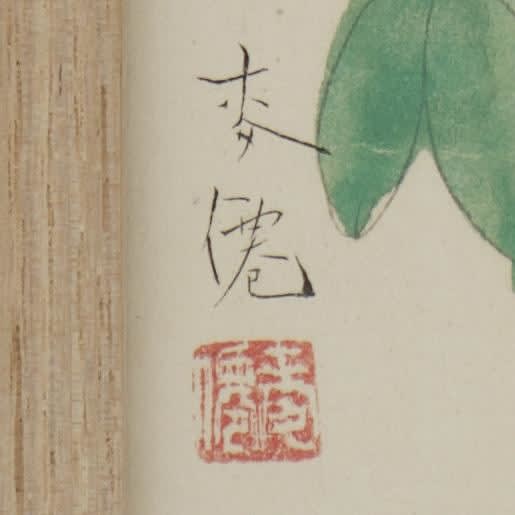Tsuchida Bakusen (1887–1936)
Chinese Peonies
Color on paper, framed
With box authentication by Tsuchida Chiyo
Inscribed “Goyoga koshitazu” on the box
Seal: Bakusen (each)
29.4 x 14.8 cm each
31.4 x 16.8 cm each (overall)
Further images
This pair of white and red Chinese peonies works was once mounted in the form of daihyogu, a type of mounting which is commonly used for tanzaku, shikishi, or other small scale works, now being altered to a simple wooden frame in a contemporary manner. In the left panel, the white peonies are in full bloom, imparting its overwhelming vitality; whereas a few of the reds gracefully stand vertical on the lower corner of the right panel, juxtaposing with the large proportion of empty space. Between the pair, the whites in motion and the reds at rest, two or three white butterflies flying across harmonize each other and generate one coherent atmosphere. The trail of the sketch remains in some of the petals; of the leaves, most are finely contoured and filled in with color, a method known as koroku, while only a handful of which adopt the mokkotsu method, filling the pigments up to the edge without outlines. The mastery of subtle color and composition brings the delicacy out. It was recorded that, in 1938, two years after Tsuchida Bakusen’s death, his wife Chiyo inscribed “Goyo-koshita-zu” (literally, a small sketch for the work ordered from high society) on the box; unfortunately the present whereabouts of the finished works remain vague. Observing by style and signature, this pair was perhaps executed in 1932 or 33; around the same time, Bakusen produced a work of ko-fusuma (a small sliding door panel), titled Melon, for the Kuninomiya family, this pair might be associated with this sequence.
Tsuchida Bakusen (nihonga painter; 1887–1936)
Niigata-born nihonga painter. His real name is Kinji. A student of Suzuki Shonen and Takeuchi Seiho. Graduated from the Kyoto Municiple Special School of Painting. Co-founded Kokuga sosaku kyokai (Association for the Creation of National Painting) with Murakami Kagaku, Ono Chikkyo, and Sakakibara Shiho in 1918. Active at Bunten (Ministry of Education Art Exhibition) after the dismember of Kokuga sosaku kyokai. His work attains a great balance between the Western style and traditional Japanese style, and embraces a sense of gracefulness and freshness. One of the most outstanding nihonga painter of his time. Member of Teikoku Bijutsuin (Imperial Fine Art Academy).
Tsuchida Bakusen (nihonga painter; 1887–1936)
Niigata-born nihonga painter. His real name is Kinji. A student of Suzuki Shonen and Takeuchi Seiho. Graduated from the Kyoto Municiple Special School of Painting. Co-founded Kokuga sosaku kyokai (Association for the Creation of National Painting) with Murakami Kagaku, Ono Chikkyo, and Sakakibara Shiho in 1918. Active at Bunten (Ministry of Education Art Exhibition) after the dismember of Kokuga sosaku kyokai. His work attains a great balance between the Western style and traditional Japanese style, and embraces a sense of gracefulness and freshness. One of the most outstanding nihonga painter of his time. Member of Teikoku Bijutsuin (Imperial Fine Art Academy).









